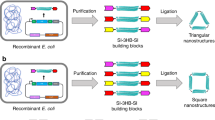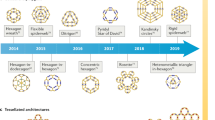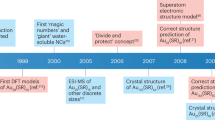Abstract
The majority of biomolecules are intrinsically atomically precise, an important characteristic that enables rational engineering of their recognition and binding properties. However, imparting a similar precision to hybrid nanoparticles has been challenging because of the inherent limitations of existing chemical methods and building blocks. Here we report a new approach to form atomically precise and highly tunable hybrid nanomolecules with well-defined three-dimensionality. Perfunctionalization of atomically precise clusters with pentafluoroaryl-terminated linkers produces size-tunable rigid cluster nanomolecules. These species are amenable to facile modification with a variety of thiol-containing molecules and macromolecules. Assembly proceeds at room temperature within hours under mild conditions, and the resulting nanomolecules exhibit high stabilities because of their full covalency. We further demonstrate how these nanomolecules grafted with saccharides can exhibit dramatically improved binding affinity towards a protein. Ultimately, the developed strategy allows the rapid generation of precise molecular assemblies to investigate multivalent interactions.
This is a preview of subscription content, access via your institution
Access options
Subscribe to this journal
Receive 12 print issues and online access
$259.00 per year
only $21.58 per issue
Buy this article
- Purchase on Springer Link
- Instant access to full article PDF
Prices may be subject to local taxes which are calculated during checkout



Similar content being viewed by others
References
Mammen, M., Choi, S.-K. & Whitesides, G. M. Polyvalent interactions in biological systems: implications for design and use of multivalent ligands and inhibitors. Angew. Chem. Int. Ed. 37, 2754–2794 (1998).
Kiessling, L. L., Gestwicki, J. E. & Strong, L. E. Synthetic multivalent ligands as probes of signal transduction. Angew. Chem. Int. Ed. 45, 2348–2368 (2006).
Jones, L. H. Recent advances in the molecular design of synthetic vaccines. Nat. Chem. 7, 952–960 (2015).
Elsabahy, M. & Wooley, K. L. Design of polymeric nanoparticles for biomedical delivery applications. Chem. Soc. Rev. 41, 2545–2561 (2012).
Rao, J. P. & Geckeler, K. E. Polymer nanoparticles: preparation techniques and size-control parameters. Prog. Polym. Sci. 36, 887–913 (2011).
Tomalia, D. A. et al. A new class of polymers: starburst-dendritic macromolecules. Polym. J. 17, 117–132 (1985).
Hawker, C. J. & Frechet, J. M. J. Preparation of polymers with controlled molecular architecture. A new convergent approach to dendritic macromolecules. J. Am. Chem. Soc. 112, 7638–7647 (1990).
Farokhzad, O. C. & Langer, R. Impact of nanotechnology on drug delivery. ACS Nano 3, 16–20 (2009).
Peer, D. et al. Nanocarriers as an emerging platform for cancer therapy. Nat. Nanotech. 2, 751–760 (2007).
Daniel, M.-C. & Astruc, D. Gold nanoparticles: assembly, supramolecular chemistry, quantum-size-related properties, and applications toward biology, catalysis, and nanotechnology. Chem. Rev. 104, 293–346 (2004).
Dreaden, E. C., Alkilany, A. M., Huang, X., Murphy, C. J. & El-Sayed, M. A. The golden age: gold nanoparticles for biomedicine. Chem. Soc. Rev. 41, 2740–2779 (2012).
Brust, M., Walker, M., Bethell, D., Schiffrin, D. J. & Whyman, R. Synthesis of thiol-derivatised gold nanoparticles in a two-phase liquid–liquid system. J. Chem. Soc., Chem. Commun. 801–802 (1994).
Giljohann, D. A. et al. Oligonucleotide loading determines cellular uptake of DNA-modified gold nanoparticles. Nano Lett. 7, 3818–3821 (2007).
Zhao, H. et al. Reversible trapping and reaction acceleration within dynamically self-assembling nanoflasks. Nat. Nanotech. 11, 82–88 (2016).
Jones, M. R., Seeman, N. C. & Mirkin, C. A. Programmable materials and the nature of the DNA bond. Science 347, 1260901 (2015).
Suzuki, K., Sato, S. & Fujita, M. Template synthesis of precisely monodisperse silica nanoparticles within self-assembled organometallic spheres. Nat. Chem. 2, 25–29 (2010).
Heindl, C., Peresypkina, E. V., Virovets, A. V., Kremer, W. & Scheer, M. Giant rugby ball [{CpBnFe(η5-P5)}24Cu96Br96] derived from pentaphosphaferrocene and CuBr2 . J. Am. Chem. Soc. 137, 10938–10941 (2015).
Ambrogio, M. W., Thomas, C. R., Zhao, Y.-L., Zink, J. I. & Stoddart, J. F. Mechanized silica nanoparticles: a new frontier in theranostic nanomedicine. Acc. Chem. Res. 44, 903–913 (2011).
Love, J. C., Estroff, L. A., Kriebel, J. K., Nuzzo, R. G. & Whitesides, G. M. Self-assembled monolayers of thiolates on metals as a form of nanotechnology. Chem. Rev. 105, 1103–1170 (2005).
Hostetler, M. J., Green, S. J., Stokes, J. J. & Murray, R. W. Monolayers in three dimensions: synthesis and electrochemistry of ω-functionalized alkanethiolate-stabilized gold cluster compounds. J. Am. Chem. Soc. 118, 4212–4213 (1996).
Hostetler, M. J., Templeton, A. C. & Murray, R. W. Dynamics of place-exchange reactions on monolayer-protected gold cluster molecules. Langmuir 15, 3782–3789 (1999).
MacLeod, M. J. & Johnson, J. A. PEGylated N-heterocyclic carbene anchors designed to stabilize gold nanoparticles in biologically relevant media. J. Am. Chem. Soc. 137, 7974–7977 (2015).
Häkkinen, H. The gold–sulfur interface at the nanoscale. Nat. Chem. 4, 443–455 (2012).
Yvon, C. et al. Polyoxometalate clusters integrated into peptide chains and as inorganic amino acids: solution- and solid-phase approaches. Angew. Chem. Int. Ed. 53, 3336–3341 (2014).
Lachkar, D., Vilona, D., Dumont, E., Lelli, M. & Lacôte, E. Grafting of secondary diolamides onto [P2W15V3O62]9− generates hybrid heteropoly acids. Angew. Chem. Int. Ed. 55, 5961–5965 (2016).
Gouzerh, P. & Proust, A. Main-group element, organic, and organometallic derivatives of polyoxometalates. Chem. Rev. 98, 77–112 (1998).
Müller, A. & Gouzerh, P. From linking of metal–oxide building blocks in a dynamic library to giant clusters with unique properties and towards adaptive chemistry. Chem. Soc. Rev. 41, 7431–7463 (2012).
Li, G., Wang, L., Ni, H. & Pittman, C. U. Polyhedral oligomeric silsesquioxane (POSS) polymers and copolymers: a review. J. Inorg. Organomet. Polym. 11, 123–154 (2001).
Spokoyny, A. M. New ligand platforms featuring boron-rich clusters as organomimetic substituents. Pure Appl. Chem. 85, 903–919 (2013).
Lee, I. S., Long, J. R., Prusiner, S. B. & Safar, J. G. Selective precipitation of prions by polyoxometalate complexes. J. Am. Chem. Soc. 127, 13802–13803 (2005).
Pitochelli, A. R. & Hawthorne, M. F. The isolation of the icosahedral B12H12−2 ion. J. Am. Chem. Soc. 82, 3228–3229 (1960).
Farha, O. K. et al.. Synthesis of stable dodecaalkoxy derivatives of hypercloso-B12H12 . J. Am. Chem. Soc. 127, 18243–18251 (2005).
Jalisatgi, S. S. et al. A convenient route to diversely substituted icosahedral closomer nanoscaffolds. J. Am. Chem. Soc. 133, 12382–12385 (2011).
Sarma, S. J., Khan, A. A., Goswami, L. N., Jalisatgi, S. S. & Hawthorne, M. F. A trimodal closomer drug-delivery system tailored with tracing and targeting capabilities. Chem. Eur. J. 22, 12715–12723 (2016).
Wixtrom, A. I. et al. Rapid synthesis of redox-active dodecaborane B12(OR)12 clusters under ambient conditions. Inorg. Chem. Front. 3, 711–717 (2016).
Messina, M. S. et al. Visible-light-induced olefin activation using 3D aromatic boron-rich cluster photooxidants. J. Am. Chem. Soc. 138, 6952–6955 (2016).
Haynes, W. M. CRC Handbook of Chemistry and Physics (CRC/Taylor and Francis, 2016).
Lundquist, J. J. & Toone, E. J. The cluster glycoside effect. Chem. Rev. 102, 555–578 (2002).
Moore, J. S. & Xu, Z. Synthesis of rigid dendritic macromolecules: enlarging the repeat unit size as a function of generation, permitting growth to continue. Macromolecules 24, 5893–5894 (1991).
Birchall, J. M., Green, M., Haszeldine, R. N. & Pitts, A. D. The mechanism of the nucleophilic substitution reactions of polyfluoroarenes. Chem. Commun. Lond. 338–339 (1967).
Becer, C. R., Hoogenboom, R. & Schubert, U. S. Click chemistry beyond metal-catalyzed cycloaddition. Angew. Chem. Int. Ed. 48, 4900–4908 (2009).
Becer, C. R. et al. Clicking pentafluorostyrene copolymers: synthesis, nanoprecipitation, and glycosylation. Macromolecules 42, 2387–2394 (2009).
Spokoyny, A. M. et al. A perfluoroaryl-cysteine SNAr chemistry approach to unprotected peptide stapling. J. Am. Chem. Soc. 135, 5946–5949 (2013).
Zhang, C. et al. π-Clamp-mediated cysteine conjugation. Nat. Chem. 8, 120–128 (2016).
Hoffman, A. S. The origins and evolution of ‘controlled’ drug delivery systems. J. Control. Release 132, 153–163 (2008).
Alconcel, S. N. S., Baas, A. S. & Maynard, H. D. FDA-approved poly(ethylene glycol)–protein conjugate drugs. Polym. Chem. 2, 1442–1448 (2011).
Veronese, F. M. & Pasut, G. PEGylation, successful approach to drug delivery. Drug Discov. Today 10, 1451–1458 (2005).
Dam, T. K., Roy, R., Das, S. K., Oscarson, S. & Brewer, C. F. Binding of multivalent carbohydrates to concanavalin A and Dioclea grandiflora lectin. Thermodynamic analysis of the ‘multivalency effect’. J. Biol. Chem. 275, 14223–14230 (2000).
Müller, C., Despras, G. & Lindhorst, T. K. Organizing multivalency in carbohydrate recognition. Chem. Soc. Rev. 45, 3275–3302 (2016).
Muñoz, A. et al. Synthesis of giant globular multivalent glycofullerenes as potent inhibitors in a model of Ebola virus infection. Nat. Chem. 8, 50–57 (2016).
Bhatia, S., Camacho, L. C. & Haag, R. Pathogen inhibition by multivalent ligand architectures. J. Am. Chem. Soc. 138, 8654–8666 (2016).
Bernardi, A. et al. Multivalent glycoconjugates as anti-pathogenic agents. Chem. Soc. Rev. 42, 4709–4727 (2013).
Munoz, E. M., Correa, J., Riguera, R. & Fernandez-Megia, E. Real-time evaluation of binding mechanisms in multivalent interactions: a surface plasmon resonance kinetic approach. J. Am. Chem. Soc. 135, 5966–5969 (2013).
Fernandez-Megia, E., Correa, J., Rodríguez-Meizoso, I. & Riguera, R. A click approach to unprotected glycodendrimers. Macromolecules 39, 2113–2120 (2006).
Kamiya, N., Tominaga, M., Sato, S. & Fujita, M. Saccharide-coated M12L24 molecular spheres that form aggregates by multi-interaction with proteins. J. Am. Chem. Soc. 129, 3816–3817 (2007).
Acknowledgements
A.M.S. acknowledges the University of California, Los Angeles (UCLA) Department of Chemistry and Biochemistry for start-up funds, 3M for a Non-Tenured Faculty Award and the American Chemical Society Petroleum Research Fund (56562-DNI3) for the Doctoral New Investigator Grant. E.A.Q. thanks the US Public Health Service of the National Institutes of Health (NIH) for the Predoctoral Training Fellowship through the UCLA Chemistry-Biology Interface Training Program under the National Research Service Award (T32GM008496). A.S. is funded by the CARE Scholars Programs (NIH grant GM055052). M.S.M. is grateful to the National Science Foundation (NSF) for the Bridge-to-Doctorate and the Predoctoral (GRFP) fellowships. P.K. acknowledges the NSF Division of Materials Research grant 1506886. H.D.M. thanks the NSF (CHE-1507735) for funding. We thank UCLA Molecular Instrumentation Center for mass spectrometry and NMR spectroscopy (NIH grant 1S10OD016387-01, NSF grant CHE-1048804). We also thank the Electron Imaging Center for Nanomachines at the UCLA California NanoSystems Institute for electron microscopy (NIH grant 1S10RR23057) and the UCLA Biochemistry Instrumentation Facility for SPR.
Author information
Authors and Affiliations
Contributions
A.M.S. developed the concept and supervised and guided the research. E.A.Q. and A.M.S. designed the experiments. E.A.Q. performed the majority of the experimental work. A.I.W., J.C.A., A.S. and J.Y.W. contributed to the synthesis of 2 and 3. A.T.R and A.L.R. performed the crystallographic characterization of compound 3. A.S., E.H.M. and D.M. contributed to the synthesis of 2j and 3j. S.C. assisted with optimizing the reaction conditions of 2a–2f, 2i, 2l, 3a–3f, 3i and 3l. A.I.W. and E.H.M. contributed to the purification of the OCNs. D.J. conducted and interpreted the TEM experiments. M.S.M. and H.D.M. assisted with the GPC experiments. P.R., Y.H. and P.K. designed, conducted and interpreted the computational experiments. E.A.Q., A.I.W. and A.M.S. co-wrote the manuscript. All of the authors commented on the manuscript during its preparation.
Corresponding author
Ethics declarations
Competing interests
The authors declare no competing financial interests.
Supplementary information
Supplementary information
Supplementary information (PDF 48732 kb)
Supplementary information
Crystallographic data for compound 2 (CIF 469 kb)
Supplementary information
Supplementary information (CIF 3407 kb)
Supplementary information
Supplementary Movie 1 (MP4 14000 kb)
Supplementary information
Supplementary Movie 2 (MP4 13857 kb)
Supplementary information
Supplementary Movie 3 (MP4 15783 kb)
Supplementary information
Supplementary Movie 4 (MP4 58910 kb)
Supplementary information
Supplementary Movie 5 (MP4 13495 kb)
Supplementary information
Supplementary Movie 6 (MP4 14059 kb)
Supplementary information
Supplementary Movie 7 (MP4 15832 kb)
Supplementary information
Supplementary Movie 8 (MP4 50324 kb)
Rights and permissions
About this article
Cite this article
Qian, E., Wixtrom, A., Axtell, J. et al. Atomically precise organomimetic cluster nanomolecules assembled via perfluoroaryl-thiol SNAr chemistry. Nature Chem 9, 333–340 (2017). https://doi.org/10.1038/nchem.2686
Received:
Accepted:
Published:
Issue Date:
DOI: https://doi.org/10.1038/nchem.2686
This article is cited by
-
Antibacterial Activity of Boron Compounds Against Biofilm-Forming Pathogens
Biological Trace Element Research (2024)
-
Therapeutic Effects of Newly Synthesized Boron Compounds (BGM and BGD) on Hepatocellular Carcinoma
Biological Trace Element Research (2022)
-
Nanoproteomics enables proteoform-resolved analysis of low-abundance proteins in human serum
Nature Communications (2020)
-
Copper catalyzed/mediated direct B–H alkenylation/alkynylation in carboranes
Science China Chemistry (2019)
-
Light-driven transformable optical agent with adaptive functions for boosting cancer surgery outcomes
Nature Communications (2018)




